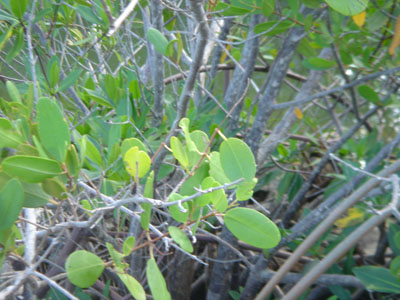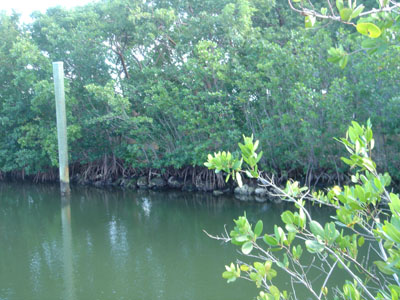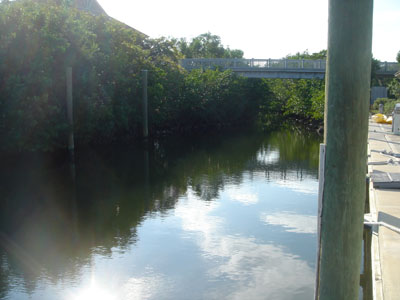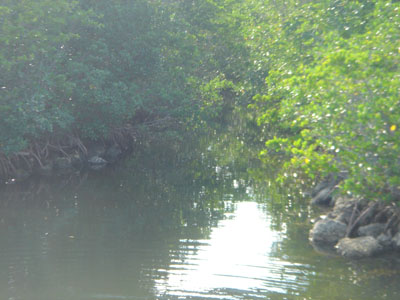
Biscayne rangers teach about nature
HOMESTEAD, Fla.— Learning about the Biscayne National Park and everything the environment has to offer is a great way to enhance a visit.
The Ranger’s Choice Program allows visitors to spend time with a ranger and enjoy his or her planned program of the day. And, of course, the program teaches visitors about the marine world that is the park.
Programs generally run from 20 minutes to one hour.
 |
Mangrove tree grows in the protected waters of Biscayne National Park (Photos by Sarah Oline). |
“We get the most visitors in the winter months,” Park Ranger Paul Kuentzel said. “From the end of hurricane season until it starts getting hot again. Plus, there are less bugs.”
“Still, we only do them on demand,” Park Ranger Jorge Acevedo said. “Unfortunately, not enough people take advantage of the program because they don’t know about it before they get here.”
Visitors are first asked to watch an optional video in the Dante Fascell Visitor Center. The colorful video informs on the general aspects of the park and everything that lives within it; the Ranger’s Program will concentrate on only one aspect of the park.
“It’s a beautiful park and extremely well-kept,” Tampa visitor Katie Lapiner said. “The rangers in the Visitor Center are very friendly and helpful.”
Rangers choose their topics so each program covers something new and interesting.
“I usually take the doom and gloom approach,” Kuentzel said. “Humans have a negative impact on the natural environment. As do barges from Miami, which bring fuel down.”
What is today’s program?
“Rangers of the Shoreline,” Acevedo said smiling.
No, not the park rangers. The mangroves.
 “The mangroves protect so much of the shoreline, I like to call them the ‘rangers of the shoreline,’ Acevedo explained. “They have many unique offerings.”
“The mangroves protect so much of the shoreline, I like to call them the ‘rangers of the shoreline,’ Acevedo explained. “They have many unique offerings.”
The program takes place just outside the visitor center where the water comes along side it and a group of mangroves stands tangled together.
Visitors can sit on a nearby bench and listen as Acevedo starts his program, first warning all to be careful of the wasps.
“Even though mangroves are often buggy and block our view of the ocean, they do a lot. For example, they are a habitat for fish – like that one!” Acevedo exclaimed as a shiny silver fish jumped from the water.
Mangroves are able to live and adapt here in South Florida so well because they thrive under harsh salt water conditions, thus allowing others to do it as well.
There are three different kinds of mangroves: red, white, and black. All three types can be found in the park. Though the mangroves were not originally protected when Biscayne became part of the national park system in 1969, today, 27 miles of mangroves shoreline (the largest in Florida) is protected.
“Mangroves have a unique, air breathing root system. This adaptation is to exchange air above the soil,” Acevedo said. “You can taste the salt across a leaf of the black mangrove. It secretes a lot of salt.”
 Acevedo points out the different mangroves to visitors and even lets everyone step down on the rocks to see the baby seedlings on the mangrove.
Acevedo points out the different mangroves to visitors and even lets everyone step down on the rocks to see the baby seedlings on the mangrove.
“The fruit is very little. It looks like a pear,” Acevedo said while comparing the fruit on the tree to the pictures he had with him.
Other important functions of mangroves include serving as a fish nursery, primarily because predators cannot swim between the mangroves, and protection from heavy storm surge and land erosion.
“The branches, or arms, of the mangroves go out and then down to create stability.” Acevedo said. “I like to call them ‘walking trees.’”
“The park ranger knew a lot about the park and the mangroves,” said visitor Matt Hoffman. “I got all of my questions answered.”
Mangroves also serve as nesting areas for local birds. Many years ago, the bald eagle even nested here.
“The mangroves withstand a lot, bad weather and woodpeckers included, that’s why I also like to call them ‘patriot trees,’” Acevedo said. “They die giving themselves to protect other species and the wetlands of Biscayne.”
Some mangroves can grow to 60 to 100 feet in height. Due to the South Florida soil, however, not many are that tall in this area.
Acevedo likes to talk about the mangroves because he has known of their importance all his life.
“I grew up in Puerto Rico and my school was only 300 yards from the shoreline. Even though the mangroves blocked my view of the ocean, I knew they were being protected,” Acevedo said. “I just developed a passion for it.”
 “I thought he was going to talk about the actual park rangers, but I’m glad it was the mangroves,” Hoffman said. “He really expressed how important they are to the life of Biscayne and other areas.”
“I thought he was going to talk about the actual park rangers, but I’m glad it was the mangroves,” Hoffman said. “He really expressed how important they are to the life of Biscayne and other areas.”
“I just came out to enjoy the day. I didn’t even know there was a program,” Miami visitor Aaron Geil said.
“It’s nice though. Some people prefer to listen to the pros.”
The Ranger’s Choice Program is a short and informative addition to a day of snorkeling, fishing, walking, or other available activities at Biscayne National Park.
“Just look around,” Kuentzel said. “Being stuck behind the desk is horrible.”
“The view is beautiful,” Acevedo agreed. “But I like to talk about the mangroves and try to paint the ugly duckling pretty. We wouldn’t have that healthy, beautiful environment without them.”
“The park is a great place,” Hoffman said. “It’s good to know the mangroves are helping protect it.”
If You Go
- Hours: Ranger’s Choice Program is offered daily, by demand, at 2:30 p.m. The Dante Fascell Visitor Center is open daily 9 a.m. to 5 p.m.
- Admission: Free.
- Facilities: Restrooms, picnic tables, Visitor Center and exhibits, free parking.
- For more information: 305-230-7275.
- Web site: http://www.nps.gov/bisc/.

Comments are Closed